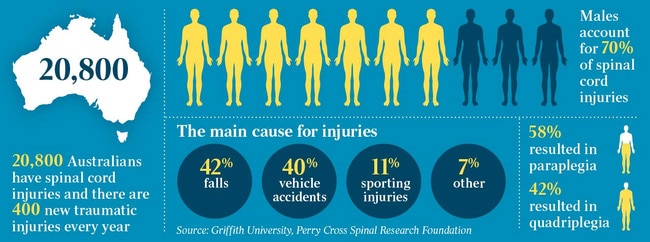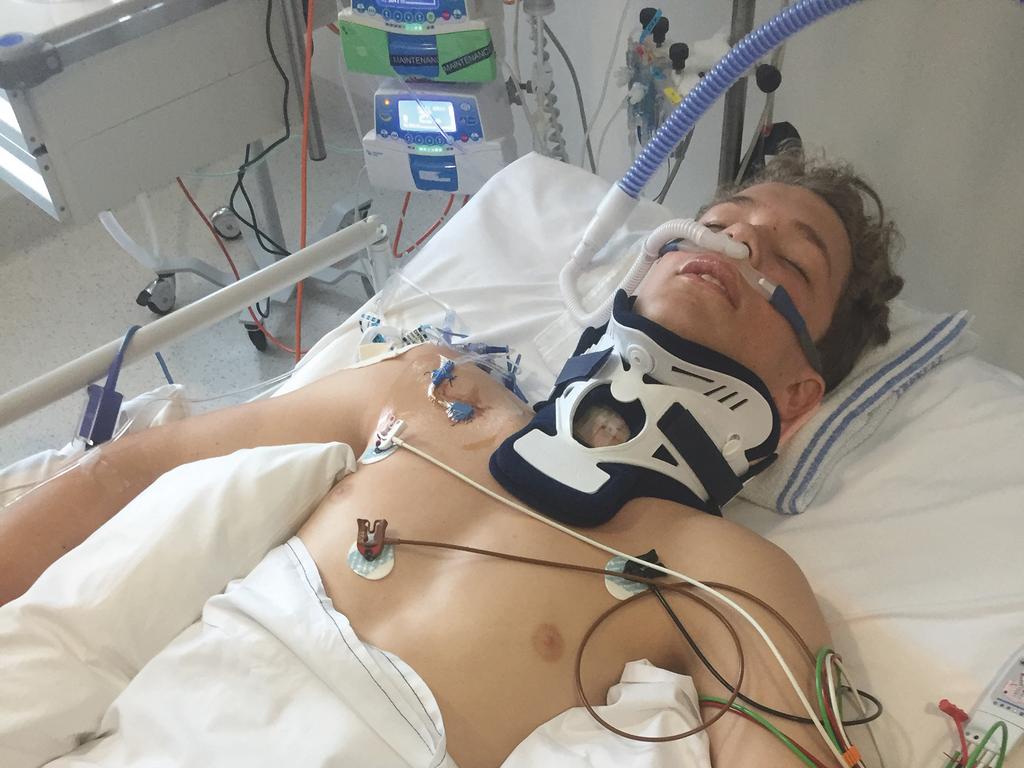A world-first trial hopes to restore movement in quadriplegics
Australian scientists will launch an ambitious bid to restore movement in patients with paralysis by surgically implanting a patient’s own cells into the site of their spinal cord injury.

In a world-first clinical trial, Australian scientists will launch an ambitious bid to restore movement in patients with paralysis.
In what is the culmination of decades of research that began in Brisbane more than 30 years ago, a patient’s own cells will be surgically implanted into the site of their spinal cord injury to promote development of new nerve connections.
Translational neuroscientists at Griffith University, together with Brisbane-based neurosurgeons, will perform the revolutionary surgery on 30 Australian patients after they successfully developed a method to grow tissue taken from the nose into three-dimensional cells.
They have also created an implantable “nerve bridge” to enable the cells to travel to the site of injury to enable regeneration and repair of damaged spine tissue.
The work, undertaken in conjunction with the Perry Cross Spinal Research Foundation, is the culmination of the groundbreaking research of the late Australian stem cell expert Allan Mackay-Sim, whose breakthroughs led to the first operation that enabled a paralysed man in Europe to walk again.
This was an isolated example following an invasive operation that has been unable to be replicated.
It is hoped the Australian clinical trial will restore movement and physical function in quadriplegics and paraplegics through a much safer method, on a large number of patients.
“This therapy is fast, cheap and effective,” said neuroscientist James St John, head of the Clem Jones Centre for Neurobiology and Stem Cell Research at Griffith University who is leading the spinal injury project.
“We are providing the conditions needed for these cells to be able to do their magic.
“By injecting these three-dimensional cells into the injury site together with the nerve bridge, they can provide a permissive physical surface for the body’s own nerve cells to grow across. We’re hoping for low outcomes, and measuring for low outcomes, but hoping for high.”
Olfactory cells are the only cells in the body that regenerate on a daily basis. Cells in the nose are constantly being replaced by stem cells that grow from the nose into the brain.
Olfactory ensheathing cells are found within the nose have an important peripheral nervous system function that it is thought can be harnessed for the body’s regeneration processes. This is why they have the capacity to regenerate damaged spine tissue.
By inserting three-dimensional cells together with a nerve bridge, the cells will be able to migrate to the injury site to repair damaged tissue.

“These cells produce a whole bunch of growth factors that help support the nerve cells, and they physically guide those nerve cells to their targets,” Professor St John said.
It’s hoped patients in the trial, to be announced in Brisbane on Monday, will over a number of years be able to restore some sense of movement as well as critical processes like bladder and bowel function.
The Perry Cross Spinal Research Foundation raised $8.5m to support the Nerve Bridge Transplantation and Rehabilitation Human Clinical Trial, which involves research specialists including bioengineers, medical doctors, biological scientists and educators.
Funding has also been provided from the Medical Research Future Fund, the Queensland government, Andrew and Nicola Forrest and the spinal injury community.
Supported with this funding, Professor St John’s team was able to continue the pioneering work of Mackay-Sim, a former Australian of the Year who died in 2023.
Mr Cross, who became a C2 ventilated quadriplegic after a rugby accident in 1994, has
dedicated his life to finding a cure for paralysis. His commitment and vision have inspired a
global community to join the cause.
“We are on the brink of a world first breakthrough that could change countless lives,” he said. “The journey to this point has been long and challenging, but with the incredible support of Griffith University, many philanthropic partners and our generous community, we have made the impossible possible.
“The clinical trial is a sign of hope for everyone living with spinal cord injuries around the globe.”
Quadriplegic Steve Ralph was part of a consumer panel that provided lived experience to the developers of the clinical trial. He suffered a C4 spinal cord injury after misjudging a dive into a swimming pool at the end of 2017 when he was 26.
“Your life just turns completely upside down overnight. Particularly without the prospect of a treatment like this, it’s a pretty tough diagnosis to hear, especially in the early stages,” he said.
“I think for people with fresh injuries, this trial is huge; the potential for that to be a reality one day, that you could go back to function,” he said.
“Even just to prove the concept that some improvements can be made, in a clinical functional sense, to people living with spinal cord injury, it’s pretty life-changing.”





To join the conversation, please log in. Don't have an account? Register
Join the conversation, you are commenting as Logout